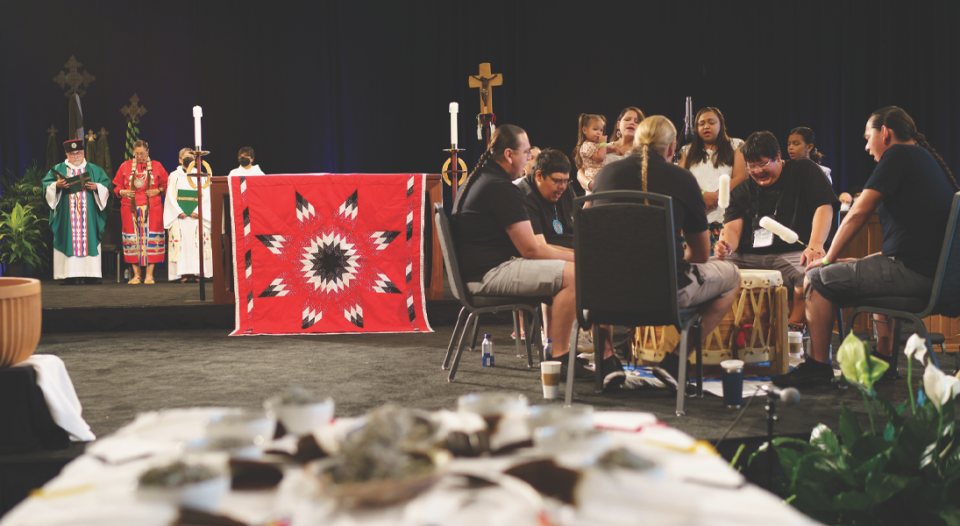In April, ELCA Presiding Bishop Elizabeth Eaton launched the Truth and Healing Movement to increase the church’s understanding of the impacts of colonization on Indigenous people in past and present generations. Living Lutheran reached out to Richard A. Magnus, a retired pastor who attends Edina (Minn.) Community Lutheran (ECLC), to hear how the congregation’s work with the movement has affected members and the community.
Living Lutheran: Could you tell me a little bit about yourself?
Magnus: My first call was to urban ministry at St. Paul Lutheran Church in Denver. My assignment was to get to know the communities of color and then invite suburban congregations into relationship with those communities. My second call was to an urban campus ministry in Boulder and the Auraria Higher Education Center, Denver. In that role I was … invited to serve on the National Indian Lutheran Board (NILB) from 1979 to 1981 as one of three “blue eyes” on the board. While in Denver I served as a mission director for the Rocky Mountain Synod and in that capacity supported Rev. Dr. George (“Tink”) Tinker in forming the Four Winds American Indian Survival Project.
In 1997, I was called [as] executive director of the ELCA Division for Outreach. In that capacity I worked with pastors Marlene Whiterabbit Helgemo, former pastor of All Nations Indian Church, and Gordon Straw, director of the ELCA Indian desk [both deceased], to form the Indigenous Institute, which trained 20 ELCA leaders in a better understanding of Native Americans.
In retirement I was invited to serve on the ELCA Repudiation of the Doctrine of Discovery Task Force, where I continue to serve on the leadership team.
Could you tell me about ECLC?
In September, ECLC will celebrate its 75th anniversary. ECLC has always had a concern for justice. In 1971, ECLC called Barbara Andrews as the first woman pastor in the former American Lutheran Church. In 1973, ECLC supported members of the American Indian Movement with meals in their Wounded Knee trial. Since the 1980s the congregation has supported homeless housing ministries. It continues to support two food shelves. In 1985, ECLC became a Reconciling in Christ congregation. Strong advocacy was given to the Minnesota Marriage Amendment. The congregation partners with Redeemer Lutheran Church in Northeast Minneapolis in the African American community, Iglesia Luterana San Pablo in southeast Minneapolis and Cristo de Paz in El Salvador. Youth groups have traveled to the Pine Ridge Reservation. In 2003 the congregation sued the state of Minnesota over requirements for churches in the “conceal and carry” law.
In a current capital campaign to reduce debt, one-tenth of all contributions are given to community partners. One of those recipients is the Indian Land Tenure Foundation. Members accompanied Pastor Helgemo to Standing Rock [Indian Reservation] to protest the Dakota Access Pipeline at least twice.
There is increasing interest [in learning] the history of settler takeover of Native land, to understand the history as having an ongoing effect on Native people and to ask what is called for from us to address current injustices.
Why did ECLC decide to engage with the Truth and Healing Movement?
The 2016 Churchwide Assembly passed the “Repudiation of the Doctrine of Discovery.” Some members paid attention to that action. The trips to Standing Rock followed. Then in 2020 the ELCA Church Council adopted the “Declaration to American Indian and Alaska Native People,” which I brought to ECLC. In October 2021 eight members under the leadership of Pastor Helgemo visited the Lower Sioux Agency, the Mille Lacs Band and the Shakopee Mdewakanton Sioux Community. Those visits were a great stimulus for more action.
In September 2021 the Indigenous Rights group was formed. [It] has offered many educational experiences for the congregation, including sacred sites tours in the Twin Cities; educational forums on the Doctrine of Discovery; conversations with Vance Blackfox, director for Indigenous ministry and tribal relations; and more. The group prepared a land acknowledgment that is used in the bulletin every Sunday and is encouraged to be used at the beginning of committee meetings, etc.
In initial planning for the ECLC’s 75th anniversary, the theme chosen was “Sacred Ground.” The study portion of the celebration in September through mid-November will focus on the fact that we are on Dakota land and encourage the congregation to ask what that means and how it should inform our relations with Native nations, hopefully as strong advocates for justice for Native nations.
The action to join the Truth and Healing Movement announced by Presiding Bishop Eaton during Holy Week this year encouraged the congregation even more to dig deeper and make even more use of the excellent resources on the ELCA website (www.elca.org/indigenous).
How has work with the movement impacted the congregation?
There is increasing interest [in learning] the history of settler takeover of Native land, to understand the history as having an ongoing effect on Native people and to ask what is called for from us to address current injustices.
The congregation had as many as 60 screens when offering Zooms on the Doctrine of Discovery, the ELCA declaration and conversations with Vance. Twenty-seven members traveled to the Lower Sioux Agency on June 17 to learn from the Rev. John Robertson, a retired Episcopal priest who now works as a cultural interpreter in the Lower Sioux Museum.
Upcoming plans include attendance at the Shakopee Mdewakanton Sioux Community Wacipi (powwow) on Aug. 19 and a sacred sites tour led by Rev. Jim Bear Jacobs of the Minnesota Council of Churches on Oct. 7. There will also be several sessions directly related to resources provided for the Truth and Healing Movement during the anniversary celebration time.
Use of the land acknowledgment statement also deepens the understanding of members and calls them to action. Here is the land acknowledgment:
My hope is that we are in the Truth and Healing Movement for the long run. There is so much to be undone to right the wrongs of our past.
“We acknowledge that Edina Community Lutheran Church is located on the traditional, ancestral and contemporary lands of the Dakhota Oyate, the Dakota nation. Treaties developed through exploitation and violence were broken. Tribes were forced to exist on ever smaller amounts of land.
“Acknowledging this painful history, we as a congregation confess our complicity in the theft of Native land and acknowledge that we have not yet honored our treaties. We further confess that Christians and Christian churches have benefited from this land theft. We commit to being active advocates for justice for Native people and to truth telling that leads to healing.”
Another item that appears in our bulletin each week is:
“At ECLC’s Annual Meeting on February 5, 2017, the congregation approved the following statement and made a commitment toward racial justice: Racial injustice continues to thrive in our country and communities. Our Christian response is to walk in solidarity with people of color, because standing silent sanctions continued violence. We recognize that those who are white, are intertwined in a network of unearned privilege. We, as a congregation, are compelled to advocate for racial justice. We invite other congregations to join together in expressing their commitments to live out our shared faith—active in love—in the struggle for equity and justice.”
What should congregations consider before they engage in this movement?
Ask yourselves why you are considering joining the Truth and Healing Movement. Ask whether you are willing to be changed by what you will learn in the process. Go to the ELCA website to see … what might be best for you to use as you begin. Find Native organizations and people who can be your guides and informers, remembering that leadership must come from those communities and people (but the work of learning will need to come from you).
Take the leap—there is so much to learn, so much to gain as you see the connectedness and begin to remove myths to be fed by the gifts of reality in the Native world these days.
Do you have any closing thoughts you want to share?
I am so grateful that our church is where it is now as it seeks to reclaim relationships that were lost with the end of the NILB. We have tremendous opportunity to become an important ally in working for Native justice. … My hope is that we are in the Truth and Healing Movement for the long run. There is so much to be undone to right the wrongs of our past. I’m a humble volunteer in an exciting justice-oriented congregation.
Correction: An earlier version of this story misspelled the author’s name and listed Richard Magnus as the pastor at ECLC. Both have been corrected. The story also included a reference to Enbridge Line 3 as the pipeline ECLC members protested with Rev. Marlene Helgemo and not the Dakota Access Pipeline. This has been corrected and clarified.






